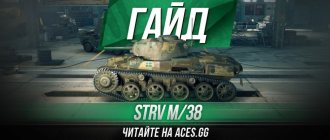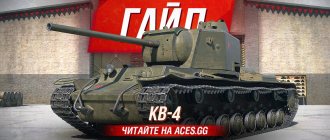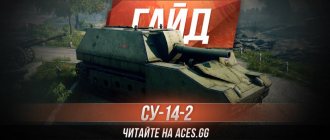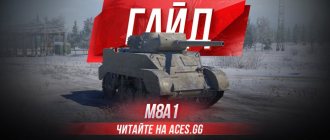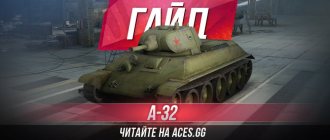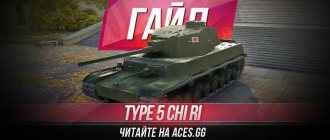Good day and welcome to aces.gg! Friends, now we will talk about real German quality, which is seriously tested in our game. We will talk about the German heavy tank of the seventh level and this is the Tiger (P) guide
.
This vehicle is upgraded along a branch that ends with the legendary, super-heavy German tank Maus, and therefore Tiger (P) performance characteristics
should also be famous for their armor. This statement is partly true, but is it really so serious?
Characteristics of the Tiger P tank
As you can see, for a TT our tank has a fairly good maximum speed and turning speed. Tiger P also has very powerful frontal armor (200mm), while the same sneaker has only 170mm. Our vehicle can be equipped with a very powerful and accurate weapon. A distinctive feature of our tank is its very good communication range.
First prototypes
In 1937, the German General Staff demanded a heavier and more powerful tank than the serial Pz III and Pz IV - and it was also supposed to serve as a breakthrough tank. According to the requirements, the mass of the new tank was supposed to be about 30 tons, the armor was about 50 mm.
Prototype VK4501(H) Henschel
As a result, the Henschel company created a prototype of the DW I tank (Durchbruchwagen - breakthrough vehicle). The chassis consisted of five rollers per side on a torsion bar suspension. The side armor of the hull was made of two parts, connected behind the fighting compartment (metallurgical plants at that time were not yet able to produce large-sized rolled armor plates with a thickness of 50 mm).
The DW II, ordered in 1938, was essentially an improved DW I with different tracks and single-plate side hull armor. The Maybach HL 120 engine, together with the eight-speed Maybach Variorex gearbox, gave the tank a speed of 35 km/h. It was planned to install a Pz.Kpfw.lV turret with a 75-mm cannon and a coaxial MG 34 machine gun on the tank. The second machine gun was supposed to be installed in the front plate of the hull on the right. As in the first case, the matter was limited to the construction and testing of the chassis.
A similar housing design was retained on the next model VK3001(H). On September 9, 1938, the Armament Directorate issued a request for the VK3001 tank. The company took its DW III prototype as a basis, replacing only the track design. At the beginning of 1940, the first tests were carried out, after which an order for 8 chassis followed. The first VK3001(H) was ready in March 1941, but already in May it was decided to abandon this project in favor of the heavier VK3601. Two more VK3001(H) chassis were completed in October 1941. These were extensively tested along with the VK3601 and subsequently the VK4501(H). After the end of the war, the VK300I chassis was found running at the Henschel test site. (Krupp) manufactured 12 towers, 6 of which - with the KwK L/24 cannon - were installed on fortifications. VK3001 was used only in schools for tank drivers; a total of 4 copies were made.
At the beginning of 1942, two chassis were converted into a heavy tank destroyer, armed with a 128 mm Rheinmetall gun. The full name of the car is Selbstfahrlafette L/61. These self-propelled guns operated on the eastern front near Stalingrad. One of them was captured unharmed by Soviet troops at the end of 1943, then exhibited as a trophy at an exhibition in 1944. Now this unique self-propelled gun can be seen in the museum in Kubinka near Moscow.
Prototype VK4501(P) Porsche
On May 26, 1941, Porsche was given an order to produce a prototype of a heavy tank armed with a cannon, the shell of which would penetrate 100 mm of armor from a distance of 1,500 m. The tank itself was to be protected from fire by the same cannon. Henschel took its VK3001(H) as a basis, but installed eight large-diameter rollers in the chassis, and Porsche used the VK3001-Leopard project. The new Henschel tank received the index VK3601(H).
The combat weight of VK3601 (N) was 32 tons, the crew was 5 people. The HL174 engine allowed a maximum speed of 40 km/h. The VK 3601 (H) was considered from the very beginning as an intermediate model, as a stepping stone to the next, more powerful combat vehicle. That is why the planned production of this tank was limited to 172 copies. At the end of July 1941, work on the tank had to be canceled due to the fact that it was impossible to complete work on the Gerat 0725 tank gun - there was not enough tungsten for its ammunition. Then it was decided to use the 88-mm KwK 36 gun (the gun was developed using the swinging part of the famous Flak-18/36 anti-aircraft gun, which also received a muzzle brake and electric release), already prepared for the Porsche VK4501 (P) tank. These towers were made. To install the Krupp turret, it was necessary to increase the clear diameter of the turret ring from 1650 to 1850 mm, which caused a change in the upper part of the hull. The VK 3601(N) received fender niches, and the weight increased to 45 tons. Design changes also led to a change in the index: the tank began to be called VK 4501 (N). Now, after a slight modernization of the Krupp turret, the VK360l project was quickly reworked into the VK4501 (H) project. Six towers manufactured for VK3601(H) were also transferred for installation on fortifications. In mid-1941, Henschel built the following two prototypes: VK4501(H)H1 and VK4501(H)H2. The H1 model was armed with an 88 mm KwK 36 L/56 gun mounted in a modified turret that Krupp had built for the Porsche VK4501(P) prototype.
The H2 model was armed with a 75 mm KwK 42 L/70 (Production) gun mounted in a new, specially designed turret. Subsequently, these towers were installed on some modifications of the Panthers. H2 existed only as a wooden model.
Study of the Tiger P tank in World of Tanks
You can research this tank on vk 3001 P.
The first step is to research the top tracks that will increase our dynamics. Next, you need to install a top-end engine, which was researched on the previous tank, and if for some reason you did not do this, then you need to research it.
Next, you can research the top turret, but if you can’t wait to install the top gun, then research it, you can still install it in the stock turret. After this we have two choices: research Tiger and go to e100, or research vk4502A and then level up to Maus.
Heavy tank Porsche VK 4501(P), Germany
In mid-1941, Porsche presented the experimental heavy tank VK 3001(P) or Typ 100 for testing. This vehicle had a number of characteristic features that distinguished it from other similar German-developed equipment. Some of these differences had a negative impact on the project as a whole and led to the fact that the customer did not want to launch mass production of the new equipment. In addition, development of a new version of the heavy tank under the designation VK 4501(P) was already underway. At the end of May 1941, the German command once again revised the requirements for a promising heavy tank. The experience of several previous projects has shown that the new vehicle should have even thicker armor and an appropriate combat weight. When using armor up to 100 mm thick, the tank should have weighed about 45 tons. It was also necessary to use a powerful weapon capable of penetrating up to 100-150 mm of armor at a distance of about 1 km. In accordance with these requirements, the development of two projects, known as VK 4501, began.
Two organizations were involved in the development of a new armored vehicle. The project from Henschel was designated VK 4501(H), from Porsche - VK 4501(P). Subsequently, the first project, which had the letter “H” in its name, received customer approval, after which the new tank went into mass production. This vehicle became widely known as the Pz.Kpfw.VI Tiger. The second project ended less successfully, with less equipment built.
Experimental tank VK 4501(P) being tested. Photo: Rascarcapaco.blogspot.ru
At Porsche, the new project received its own designation Typ 101. In addition, other names were used at different stages of development. Designations were used that reflected the combat weight of the vehicle (VK 4501), serial number in the troops (Pz.Kpfw.VI), etc. Most of the renaming was carried out in accordance with the orders of the customer, represented by the army.
The new project proposed to use existing developments as widely as possible, taking into account updated requirements for technology. It was planned to maintain the main provisions of the project, as well as make some changes to the armor and weapon system. This made it possible to speed up the development of the project while still meeting existing requirements. This approach made it possible to reduce the number of newly developed components and assemblies.
The existing hull, created as part of the previous project, received enhanced armor. Its frontal part was to be assembled from sheets up to 100 mm thick; the protection of the sides and stern was assigned to 80 mm parts. Due to changes in the thickness of the armor, the contours of the frontal part of the hull had to be changed. In addition, the design of the upper part of the hull, which formed developed fender niches, was adjusted. Between the upper frontal and side parts there were beveled cheekbones. The 25 mm horizontal hull roof at the rear of the vehicle was connected to an inclined sheet.
Tiger(P) tank diagram. Drawing Rascarcapaco.blogspot.ru
Also, as part of the project, an updated version of the turret used on the previous version of the heavy tank was developed. The tower had a vertical frontal plate, and was also equipped with a curved part that served as the sides and stern. In terms of protection level, the turret of the new tank did not differ from the hull and consisted of sheets up to 100 mm thick.
The layout of the VK 4501(P) tank was to be completely borrowed from the previous project. The front part of the body housed the electrical transmission units and some mechanical devices, behind which the control compartment was located. The center of the hull housed the fighting compartment, and the power plant was located in the stern.
The armored vehicle type VK 3001(P) was equipped with two gasoline engines with a power of 210 hp each. To compensate for the increase in combat weight, the tank needed more powerful engines. As part of the VK 4501(P) project, a new Typ 101 carburetor engine was developed. This product differed from its predecessor by one and a half times the volume and power of 310 hp. Two new engines were to be placed in the rear of the hull. Next to them were two Siemens sGV 275/24 electric generators with a power of 275 kW each. Using a set of cables, electricity was supplied to Siemens D1495a electric motors located in the front of the case. Through final drives, electric motors rotated the front drive wheels.
The promising heavy tank retained the basic control principles proposed in the previous project. The driver could change the operating parameters of two gasoline engines, but the main means of control was a set of systems that made it possible to change the parameters of the current supplied to the traction motors. Gasoline engines could operate in the same mode.
An experimental chassis with a turret weight simulator being tested. Photo by Chamberlain P., Doyle H. “A Complete Guide to German Tanks and Self-Propelled Guns of the Second World War”
The chassis with modifications was borrowed from the previous tank. It was proposed to use six dual large-diameter road wheels on each side. The authors of the project abandoned the use of rubber bands, but retained the general architecture of the chassis. The rollers were blocked in pairs, and their bogies were mounted on torsion bars. To save space inside the car, torsion bars were placed outside and also placed along the body. The drive wheels were placed in the front of the chassis with a noticeable excess over the road wheels. There were guide wheels in the stern. The upper branch of the caterpillar lay on the support rollers, without the need for support rollers. For the VK 4501(Z) tank, two track options were developed. The 500 mm wide product was intended for transporting equipment on roads and railways, and for operation in the field a 600 mm caterpillar should be used.
The main armament of the tank was supposed to be placed in a rotating turret. Initially, it was planned to use a promising 88-mm gun as the “main caliber”. Calculations showed that for such a tank gun it is necessary to increase the size of the fighting compartment, as well as increase the diameter of the shoulder strap to 2 m. Due to the specific coordination of the work of different enterprises and the customer, an order appeared for the development of a turret for a shoulder strap of a smaller diameter, which could only carry 75 mm gun. Subsequently, the problems with the fighting compartment were resolved, and the customer and developer chose the required type of weapon.
The main armament of the Type 101 heavy tank was decided to be an 8.8 cm KwK 36 tank gun with a 56-caliber barrel. This gun met the customer’s requirements regarding combat qualities, and also had acceptable dimensions and could be installed on a promising tank. It was proposed to equip the gun with a binocular telescopic sight and install it on a swinging system. With the help of turret rotation drives, circular horizontal guidance was provided. Elevation angles varied from -9° to +18°.
Checking the chassis on rough terrain. Photo: Aviarmor.net
It was proposed to mount a coaxial MG 34 machine gun of 7.92 mm caliber on the same installation with the gun. It was initially decided to abandon the second machine gun in the installation of the front hull plate. Subsequently, the installation of the housing was nevertheless included in the project. The gunner had to control the coaxial machine gun, and the gunner-radio operator had to control the course gun. The crew could also have had several submachine guns at their disposal, used as self-defense weapons.
By increasing the size of the hull and fighting compartment, it was possible to place fairly large and voluminous racks for ammunition in the tank. The ammunition load of the 88-mm gun could consist of 64 shells. For use with a machine gun, it was proposed to transport over 4,300 rounds of ammunition. There was also space to carry six magazines for submachine guns with 192 rounds of ammunition.
The crew of the VK 4501(P) / Typ 101 tank was supposed to consist of five people. The driver and radio operator were located in the front of the hull. They could observe the situation using hatches in the frontal and zygomatic sheets of the hull. At their workplaces there was a set of all necessary controls. So, the driver had the means to control the car, and the radio operator had two types of radio stations.
Studying technology. Photo by Chamberlain P., Doyle H. “A Complete Guide to German Tanks and Self-Propelled Guns of the Second World War”
The turret had seats for the gunner, commander and loader. The commander could conduct observation through a set of observation devices on his own turret. The loader had similar systems, but with smaller viewing angles. The gunner had to use the sight available in his place. There were two hatches in the turret roof and on the turret for access to the inside of the vehicle.
An interesting feature of the new project was the ergonomics of the fighting compartment and the unusual way of landing the crew in their seats. For a number of technical reasons, the tank's turret was moved forward as much as possible, which is why its frontal part overlapped the roof of the control compartment, preventing it from being equipped with hatches. As a result, the entire tank crew had to get inside the vehicle only through two hatches in the turret roof. First, the driver and radio operator had to get into the tank, then the gunner, commander and loader had to climb into it. It was proposed to disembark in the reverse order.
Increased protection and firepower led to an increase in size and combat weight. The length of the Type 101 tank along the hull was 6.6 m, including the gun - 9.34 m. The width reached 3.4 m, height - 2.8 m. The combat weight significantly exceeded the required 45 tons and reached 57 tons. With such an increase in weight, the tank, according to calculations, was supposed to reach speeds of up to 35 km/h. The power reserve did not exceed 105-110 km.
Tank with a turret on the highway. Photo: Aviarmor.net
The preliminary version of the VK 4501(P) project was ready by the end of June 1941. Soon a document appeared that stipulated the schedule for subsequent work. Also during this period, the project was given the additional name Tiger. Subsequently, in order to avoid confusion with a competing project from Henschel, the Porsche tank began to be called Tiger (P). The existing designations were also retained. The signed documents, among other things, stipulated the participation in the project of various subcontractor firms, from which the supply of certain components was required.
According to available data, by the end of July 41, several agreements were signed for the supply of a significant number of components for new tanks. Thus, during a given period, Krupp had to assemble and send for assembly 100 hulls and the same number of turrets for the Tiger (P) tank. In accordance with these contracts and the approved plan, one hundred new armored vehicles were to be delivered to the customer from spring to autumn 1942. There is also a widespread opinion that the assembly of the first large batch of tanks was launched by the unauthorized decision of Ferdinand Porsche, but this contradicts other information.
The assembly of armored hulls for the VK 4501(P) tanks started at the very end of 1941. The production of such products continued until mid-1942. The first turrets, for various reasons, were released only in mid-spring 1942, after which it was possible to begin assembling prototypes. According to available data, as part of the first order, a total of no more than 65 chassis and only 15 towers were built, of which only 10 prototypes were assembled.
Transportation of VK 4501(P) by rail. Photo: Wiki.warthunder.ru
The first prototype of the promising heavy tank entered testing at the end of the winter of 1942. Due to the lack of the required fighting compartment, it was decided not to equip the existing chassis with a turret, instead of which a weight simulator should be used. The chassis did not demonstrate very high mobility characteristics. There were also problems with the operation of individual units. The first prototype performed poorly during factory tests, which is why it was sent for revision. Instead, the customer was presented with the next experimental batch vehicle with a similar configuration for testing.
By this time, shortcomings of individual elements of the armored vehicle had been identified. Thus, the new type of engines had insufficient reliability and could not withstand prolonged operation at maximum power, which could lead to the destruction of their parts. Also, the developers and the customer were not satisfied with the design of the tower, which should have been improved. During May 1942, a comprehensive list of necessary changes was compiled that should have been made to certain components and assemblies of the vehicle.
Initially, the customer considered a heavy tank from Porsche as the favorite of the existing program. However, as testing progressed, the opinion of army specialists changed. Over time, the VK 4501(H) tank began to be considered a more promising development. At the beginning of July 1942, a report was drawn up on joint testing of two armored vehicles, which noted the advantages of the Tiger (H) tank. According to experts, it took at least a year to finalize the competing car. Because of this, it was considered unsuitable for adoption and mass production.
Tank with a turret in a field. Photo: Wikimedia Commons
By the time the tests were completed, the leadership of Nazi Germany came to the conclusion that the parallel construction of two heavy tanks of different types was impossible. The industry was loaded with a mass of other orders, because of which a choice had to be made. After the test report appeared, the decision became obvious, but the further fate of the two heavy tanks had to be determined through additional tests. In mid-November, comparative tests of the two tanks took place, during which both vehicles presented showed not only advantages, but also disadvantages. However, the Henschel tank performed better than its competitor.
They decided to put the development of the Henschel company into series, while the further development of the Typ 101 project was considered unpromising. Soon the VK 4501(H) tank was put into service under the name Panzerkampfwagen VI Tiger. The Tiger(P) project was closed due to lack of prospects on November 22, 1942. The official document on this completion of the project was signed a little later, in December. By this time, eight experimental vehicles had been built, differing from each other in configuration, equipment, purpose, etc. In addition, two buildings were built for testing, not equipped with internal units.
On December 10, the army demanded the development of two options for modernizing the existing tank using new engines and transmission units. The Typ 130 tank was supposed to receive one Maybach HL 120TRM engine instead of two separate engines, and the Typ 131 project meant replacing the electric transmission with hydraulic systems. After completing the development of the updated projects, it was planned to rebuild a number of available VK 4501(P) chassis based on them. Subsequently, almost all armored vehicles built received new engines.
Self-propelled guns Elefant / Ferdinand. Photo: Wikimedia Commons
The constructed equipment was used for various purposes. Thus, prototypes of the “Type 101” were used in various new projects as a platform for testing new ideas and solutions. One of the fully equipped tanks, which received a turret and weapons, according to some sources, was sent to the Eastern Front in the spring of 1944 for testing in real combat conditions. This vehicle was used until mid-summer, when it was destroyed during one of the battles.
After the project was closed, it was decided to complete the laid down chassis of the VK 4501(P) type, and also use them as the basis for new equipment. A total of 90 chassis were assembled, which during completion and modernization were equipped with new types of engines. Subsequently, these chassis were used in the construction of the Sturmgeschütz mit 8.8 cm StuK 43 or 8.8 cm StuK 43 Sfl L/71 Panzerjäger Tiger (P) self-propelled artillery mount with an 88-mm PaK 43 anti-tank gun. Subsequently, these vehicles received a wide known as Elefant/Ferdinand.
The Porsche VK 4501(P) / Typ 101 heavy tank project did not produce real results. Several prototype vehicles were built, as well as a significant number of pre-production chassis. At the same time, only one fully equipped tank entered the army, which managed to participate in the war on the Eastern Front for some time. Other pre-production samples stood idle for a certain time, after which it was decided to use them in the construction of new self-propelled guns. After such a conversion of the existing chassis, production of the VK 4501(P) did not continue as unnecessary. Henschel managed to create a more successful version of the heavy tank, which, after fine-tuning, was put into service and sent into mass production. Later, Porsche made an attempt to improve the existing project, but it was too late to correct the existing situation.
Based on materials from: https://achtungpanzer.com/ https://aviarmor.net/ https://panther-panzer.de/ https://vn-parabellum.narod.ru/ Chamberlain P., Doyle H. Complete reference book German tanks and self-propelled guns of the Second World War. – M.: AST: Astrel, 2008. Baryatinsky M.B. Heavy tank "Tiger" // Armor collection. 1998. No. 6.
Tactics for playing Tiger P in World of Tanks
Due to the accurate top gun, we can sit somewhere in the bushes and shoot the enemy; this tactic works when you are in compositions with high levels.
Also, when you get to the top, you can go on the attack, but with the support of your allies! When you are at the top, you should not be too heroic; although you have strong frontal armor, a maneuverable enemy can go around you and deal a critical blow. Therefore, you need to carefully plan your game strategy and watch where your allies are heading.
Sd.Kfz.181 PZ.Kpfw VI "Tiger"
The first heavy tank of the Wehrmacht, produced in large quantities. Before the advent of the Soviet tank, the IS-2 had no equal in terms of weapon power and armor protection. Produced by the Henschel and Weggman factories. From September 1942 to August 1944, 1,355 tanks were manufactured.
SERIAL MODIFICATIONS: Pz.VIE is the only variant of the “Tiger”. During production it was partially modified and improved. The first 495 tanks were equipped with equipment that allowed them to overcome water obstacles up to 4 m deep. The last 800 tanks had road wheels with internal shock absorption. Starting from the 251st vehicle, the tanks were equipped with the Maubach HL 230 P45 engine. From the second half of 1943, the original design of the commander’s cupola was replaced by a new one, unified with the “Panther”. Other less significant changes were also made.
Pz.VIE entered service with heavy tank battalions. They were first used in the fall of 1942 on the Leningrad Front as part of the 502nd heavy tank battalion. Two months later, the Tigers of the 501st battalion entered the battle in North Africa. The most successful tankers of the Second World War served and fought in these two tank units: Hauptsturmführer Wittmann and Lieutenant Belter. Together they destroyed 144 enemy tanks.
181 Pz.VIE tanks took part in Operation Citadel in the summer of 1943. During July, Soviet troops destroyed 34 Tigers.
“Tigers” were actively used on all fronts until the end of the war. On March 1, 1945, the Wehrmacht had 185 tanks of this type, of which 142 were in the field troops and 43 in the reserve army.
The only country where Tigers were actually exported was Hungary - in 1944 it received 3 vehicles.
Self-propelled artillery mounts, command tanks and evacuation tractors were built on the basis of the Pz.VIE tank.
TACTICAL AND TECHNICAL CHARACTERISTICS OF THE Pz.VIE “Tiger” TANK
COMBAT WEIGHT, t: 56.9. CREW, people: 5. OVERALL DIMENSIONS, mm: length – 8450, width – 3705, height – 3000, ground clearance – 430. ARMAMENT: 1 KwK 36 gun, 88 mm caliber; 2 MG 34 machine guns. AMMUNITION: 92 artillery rounds, 5100 rounds. AIMING DEVICES: binocular telescopic sight TZF 9a. RESERVATION, mm: forehead-100; board, stern-82; roof, bottom-28; tower-28-100. ENGINE: Maybach HL 210 RZO, 12-cylinder, carburetor, V-shaped, liquid cooling, power 650 hp. (478 kW) at 2600 rpm, displacement 23,095 cc. see TRANSMISSION: multi-plate main clutch with oil bath friction; shaftless gearbox (8+4); planetary turning mechanisms, final drives. CHASSIS: 24 road wheels in four rows per side, front drive wheel with removable ring gears (pinion engagement); suspension - individual torsion bar; each caterpillar has 96 tracks with a width of 725 mm. MAX. SPEED, km/h: 45.4. POWER RESERVE, km: 100. OBSTACLES OVERCOME: ascent angle, degrees. – 35; ditch width, m – 2.3; wall height, m – 0.179; ford depth, m – 1.2. COMMUNICATIONS: radio station Fu 5
Gear and equipment for Tiger P
- I advise installing a rammer;
- vertical drives and ventilation.
In this situation, the IS will go away in a couple of minutes, and this will give us a chance to deal more damage per minute.
As for crew perks:
As for equipment, I advise you to take a repair kit, a small first aid kit and 100-octane gasoline. The repair kit is taken according to the standard, we took a small first aid kit, since the tank has problems with concussion of the crew, and 100-octane gasoline will allow us to accelerate faster and increase our dynamics.
Tiger, Elephant and Mouse: Porsche supertanks
Like many automobile manufacturers, Porsche also has a military history. Although with varying degrees of success, during World War II they produced tanks for the army of the Third Reich.
Sergei Yakovlev
"Tiger"
Panzerkampfwagen VI or "Porsche's Tiger" was introduced in 1942, but remained at the stage of a promising idea. The tank did not go into production due to the electric transmission, which required a large amount of scarce copper for production, although the vehicle itself was actually ready for serial production. Therefore, based on the results of the military commission, another “Tiger” was chosen. The Porsche tank was equipped with two air-cooled V10 engines of 320 horsepower each, which powered two generators, which in turn fed two traction electric motors that drove the drive wheels. A total of five Porsche Tigers were built, and all of them were transferred to the Döllersheim plant for training.
"Tiger- II"
A similar story happened with the second Tiger from Porsche. While developing a new project for an even more powerful and protected tank, Porsche took his previously rejected project as a basis. The resulting heavy tank was to become the most powerful production tank of the Second World War and the last production heavy tank of Nazi Germany - the “Royal Tiger”. But the project was again rejected, and the German leadership again chose the concept of Henschel und Sohn. However, by the time Porsche's project was rejected, fifty towers had already been produced for the new model. These towers were distinguished by their streamlined shape and the base of the commander's cupola protruding beyond the side wall. It was decided to use the manufactured turrets to arm the first 50 tanks with Henschel hulls. So the first “Royal Tigers” still received something from Porsche.
"Elephant"
The Ferdinand heavy self-propelled artillery mount, named after Porsche himself, was one of the most heavily armed and heavily armored representatives of German armored vehicles of that period. For which it received its second name - “Elephant” or “Elephant”. The “Elephant” was developed in 1942-1943, and was essentially an improvisation based on the chassis of the first Porsche Tiger. The project was created in great haste and carried many experimental solutions, new and unusual for German and world tank building. The most noticeable of them are the electric transmission and suspension using longitudinal torsion bars. However, despite being somewhat expensive to operate, the artillery mount showed good combat qualities and lasted until the fall of Nazi Germany. “Elephant” made its debut at the Battle of Kursk in 1943, and took its last battle in the vicinity of Berlin in the spring of 1945.
"Mouse"
The super-heavy tank Panzerkampfwagen VIII “Maus” or simply “Mouse” produced by Porsche was the largest tank in terms of weight in the history of armored vehicles. Its combat weight was 188 tons. The vehicle was made in only two copies and did not take part in combat operations (mainly due to its inability to conduct close combat). The “Mouse” was equipped with a 12-cylinder V-shaped turbo engine with a capacity of 1080 (on the second copy - 1250) horsepower. Although the tank had two fuel tanks of 1,560 liters each, the range was only 180 kilometers. In April 1945, as Red Army units approached the training ground, the Germans destroyed the Mouse prototypes. They blew up both tanks, but only one suffered significant damage. One tank was later restored and is still kept in the Armored Museum in Kubinka.
The editors recommend:
When car prices will drop: there won’t be long to wait
The Russian car market has collapsed by 20%
Russian car dealers have surpassed Italian ones
An alternative to a scraper: how to clean car windows without scratching them
